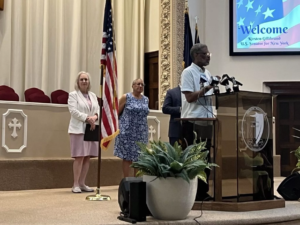A monument to the Tiananmen Square massacre faces the threat of removal, part of a broader effort in Hong Kong to erase the public memory.
Under the relentless crush of Beijing, the courtrooms of Hong Kong have become some of the few venues safe for protest in the city. Defendants accused or convicted of political crimes have turned otherwise banal hearings and bail applications into opportunities to voice dissent and challenge the arduous legal process.
In mid-November Lee Cheuk-yan, a veteran prodemocracy figure, used his mitigation hearing, where defendants can address the court in hopes of obtaining a lesser sentence, to deliver a stirring and defiant speech. He recounted his memories of the 1989 Tiananmen Square massacre, exalted Hong Kongers for never forgetting the tragedy, and excoriated city officials for curtailing basic freedoms. Lee, who for decades helped organize the annual vigil held in Hong Kong’s Victoria Park to mourn the crackdown, choked up as he addressed the courtroom.
“I want to thank the people of Hong Kong who kept the promise of 1989,” he said. “In the face of suppression, they persisted, honoring the memory of the June Fourth Massacre in Victoria Park with their candlelight. Your Honor, the people of Hong Kong who took part needed no person or organization to incite them. If there was a provocateur, it is the regime that fired at its own people.
“For 31 years,” he continued, “our unyielding memory and unrelenting conscience drove us to keep the promise, persist in honoring their memory, demand truth and accountability, and carry on the pursuit of freedom and democracy of the Chinese people.”
Yet the unyielding memory of which Lee spoke has come under sustained attack this year, part of a broader effort by Beijing, its loyalists in the city, and an ever-growing list of collaborators to erase Tiananmen from public memory. Weaponizing pandemic protocols and vague threats of possible national-security violations, authorities have canceled the once-annual vigil for the past two years. Prominent activists, Lee included, who took part in prior gatherings have been arrested. A museum dedicated to Tiananmen was abruptly closed. Its contents were hauled away by police as evidence against members of the Hong Kong Alliance in Support of Patriotic Democratic Movements of China, which organized the vigil and ran the museum. The group disbanded as a result. Unsatisfied with residents being only physically barred from viewing its displays, Hong Kong officials blocked access to the museum’s website as well. An investigation by Hong Kong Free Press found that dozens of books on the topic of Tiananmen have disappeared from the city’s libraries.
One monument that has escaped erasure, just barely and perhaps only briefly, is also the city’s most prominent dedicated to Tiananmen, the Pillar of Shame statue. An orange cenotaph of pained, contorted bodies constructed as a memorial to protesters killed in the massacre, it was put on permanent public display to serve, as its creator, Jen Galschiøt, wrote in 1997, as a test of the authorities’ “guarantees for human rights and freedom of expression in Hong Kong.” The pillar was staged at the University of Hong Kong, the city’s oldest and most prestigious institute of higher learning, in 1998, after being displayed at other campuses.
For more than two decades, the city passed Galschiøt’s assessment. Students and activists gathered every spring to ceremonially wash the structure, which across its base reads The old cannot kill the young forever. The ritual was the first in a sequence of events held every year in Hong Kong to mark the anniversary of the Tiananmen massacre culminating with the candlelight vigil. Now, though, the pillar is caught in a sort of purgatory—unwanted by the university, which has tried to remove it but faced fierce resistance, and Galschiøt’s attempts to retrieve it have gone unanswered. The awkward situation is representative of the city itself, not entirely subjugated by Beijing but not as free, open, or vibrant as it once was.
“Many things in the past in Hong Kong that were treated as normal and being a kind of symbol that Hong Kong is still enjoying freedom and a high degree of autonomy … are now facing challenges,” Richard Tsoi, the secretary of the now-dissolved alliance, told me.
The attempts at removing the horrors of Tiananmen from the popular consciousness follow a full-scale effort to rewrite more recent history in Hong Kong. Officials have consistently attempted to twist the narrative of the city’s protest movement, portraying the demonstrations as organized by a small, violent group, conspicuously omitting the occasions when more than 1 million people marched peacefully. The reasons behind the protests have been obfuscated as well. Blame, officials now say, lies with the United States and astronomical housing prices, not the continued erosion of freedoms and broken promises from Beijing. The police have taken part in some of the most blatant acts of historical revisionism, hoping that residents will forget violent actions they witnessed with their own eyes.
“The authorities … are working overtime to teach us what is the official position,” John P. Burns, an emeritus professor at HKU and the former dean of its faculty of social sciences, who has written in support of keeping the statue, told me. “Making Hong Kong more like the rest of China, that is the name of the game.”
In 1989, residents of Hong Kong were horrified by Beijing crushing the protests at Tiananmen Square. Hundreds of thousands of people marched in what The New York Times described as a “long ribbon of humanity” that stretched through the city’s streets. The outrage extended beyond those who supported full democracy. Many who signed published petitions denouncing Beijing’s actions and who took part in demonstrations are pro-Beijing stalwarts today. David Ford, then the territory’s chief secretary, wrote in a letter to the city’s vaunted civil service that residents felt a “profound feeling of shock and grief,” at what had occurred. Authorities in Beijing believed then that the city’s protests would be a one-off event, according to a former Hong Kong government official who requested anonymity because of the sensitivity of the topic, and that the territory would revert to being a purely “economic city,” whose inhabitants were uninterested in politics. This hypothesis—like many made by Beijing about Hong Kong—was totally incorrect. Instead, Hong Kong fostered a lively tradition of protests and demonstrations.
Galschiøt’s two-ton sculpture was unveiled in downtown Victoria Park eight years after the massacre and 28 days before the city’s July 1, 1997, handover to China. It was eventually relocated to HKU’s campus, and activists painted it bright orange in 2008. The artist wrote at the time of its installation that “no ban on the sculpture can diminish its symbolic value. No attack, not even the destruction of the sculpture can obliterate the symbolism of the Pillar of Shame.” One of his tenets is now being tested: “No authority will ever succeed in preventing the mounting of the Pillar of Shame in Hong Kong.”
Following the disbandment of the alliance, HKU tried to have the sculpture removed, enlisting the global law firm Mayer Brown to help. In a statement to news outlets, Lisa Sachdev, a spokesperson for the firm, said that Mayer Brown was “asked to provide a specific service on a real-estate matter for our long-term client, the University of Hong Kong.” She continued: “Our role as outside counsel is to help our clients understand and comply with current law. Our legal advice is not intended as commentary on current or historical events.” (The firm regularly comments on U.S. news events, though, including the death of George Floyd and voting-rights issues, and Mayer Brown later relented after its involvement drew considerable press and condemnation, saying, “Going forward, Mayer Brown will not be representing its long-time client in this matter.”)
Galschiøt hired his own lawyers in an effort to reclaim the statue himself. He said in an open letter this month that he would travel to Hong Kong to remove the statue but would need assurances from authorities that he wouldn’t face any legal issues. This seems highly unlikely because Galschiøt has been barred from entering Hong Kong on two previous occasions. He added that HKU has not responded to his inquiries. The university did not address the contents of Galschiøt’s letter and, when asked for comment, said only that it was working to resolve the issue in a “legal and reasonable manner.”
HKU and other universities in the territory have quickly moved to submit to Hong Kong’s new, more authoritarian political order. Maintenance workers at the university removed colorful walls of protest art, and the administration cut ties with the students’ union and barred some of its members from campus because of a union motion expressing sympathy for the “sacrifice” of a man who had killed himself after stabbing a police officer in July. The students later apologized and retracted the statement, but four were arrested under the national-security law and charged with advocating terrorism.
Burns told me that by moving to remove the sculpture, the university is “acknowledging its dependence on the mainland and on authorities in the mainland for the things the university wants.” One professor, who asked not to be named for fear of repercussions, told me that the threat of removal was part of “a wholesale embrace of the wider crackdown that we have seen in the media, civil society, and the general public,” and that the university was in “free fall into a totalitarian-friendly tertiary institution.” Another professor, who also spoke on condition of anonymity, told me about recently going out of their way to walk by the statue with colleagues to confirm that it was still standing. “I find campus very depressing,” the academic said, “because of everything that is no longer there.”
In court, Lee said that even while in jail earlier this year after being convicted for his role in a 2019 protest, he continued to uphold the memory of June Fourth by fasting and, without access to a candle, lighting a single match.
“I am proud to be a Hong Konger,” he said. “For 32 years, we have marched together in the fight to bring justice to those who put their lives on the line on 4 June 1989, and in the struggle for democracy.”
In the end, he told the judge that he was at peace with any sentence that might be handed down: “If I must go to jail to affirm my will,” he said, “then so be it.”




